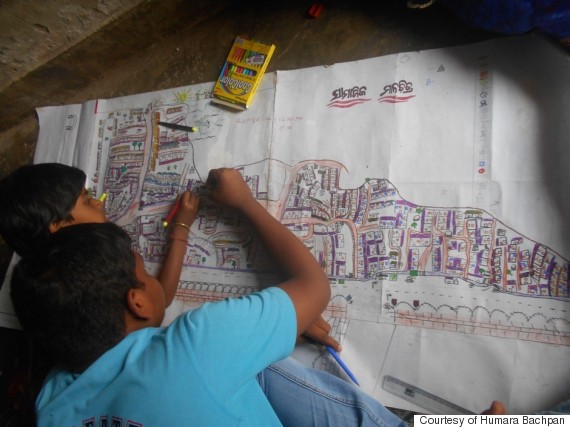Struggling Indian kids have heard their government’s promises, but they haven’t seen much action –- so they’re taking matters into their own little hands.
More than 65 million people reside in India’s slums, where children are obligated to shoulder chores and crises that typically belong to adults, but they get no say in how their quality of life could improve with feasible solutions.
That’s why children’s organization Humara Bachpan is encouraging slum kids to map out the failings of their neighborhoods -- and how they can be fixed -- in order to inform government officials, City Lab reported.

The kids team up with adult leaders and spend about 45 days scouring the city and determining what’s "needed through the eyes of the children."
After drawing up their ideal neighborhood, leaders from the child clubs present them to local politicians, the Asian Age reported.
And while the kids are keen on playing in parks, instead of on dangerous roads, they’re also just as eager to secure such basics as functioning toilets, garbage cans and streetlights.
Less than one third of the population in India has access to sanitation, so people often defecate in the open, which in turn pollutes the drinking water and leads to severe illnesses, and sometimes, death.
"As there is a lack of toilet facilities we children have to defecate in the nearby open field," 13-year-old Narayan, a child leader who lives in a slum, told the Asian Age. "I usually have to control my urge to defecate in the open during the morning hours as there are people around and I feel ashamed to do it. I have to wait till it gets dark."

In India alone, more than 186,000 children under 5 die every year from diarrheal diseases, according to WaterAid, preventable conditions that are directly tied to the dire lack of sanitation.
And while some slums are equipped with working toilets, they often aren’t accessible to young people. Narayan noted that there’s a "big lock" on the public toilet that keeps him from using it. Often, the latrines aren’t structured properly to fit a child’s body.
When a dozen students from Harvard’s School of Public Health traveled to Cheeta Camp, a slum in Mumbai, to map out the area’s toilets in 2012, they uncovered that very issue, The New York Times reported.
While poor residents were inclined to use the pay toilets, over the free public ones, the children wanted nothing to do with either of those options.
"Pay or no, small children do not generally use any of the toilet facilities, finding them too big, messy and intimidating," The Times reported. "Instead, they generally do their business in the open, directly into sewers or near drains."
Humara Bachpan’s mission is centered on enabling kids to express their concerns in order to effectively improve their health and well-being.
Last year, 150 children from 22 clubs in Berhampur came together to form the first children’s federation, under the auspices of the group Youth for Social Development, according to Humara Bachpan.
Supporters have been bolstered by the fact that politician appear to be listening.
"I will make sure that the children’s matter is taken into cognizance," Ananta Narayan Jena, mayor of Bhubaneswar, told the Asian Age. "And I will support Humara Bachpan and the child leaders to give all the necessities that they are seeking to get."
Learn more about Humara Bachpan and how you can get involved here.
Related
Before You Go






